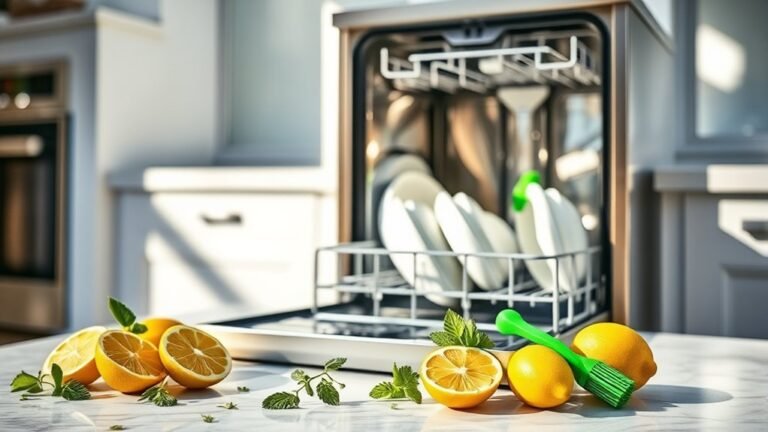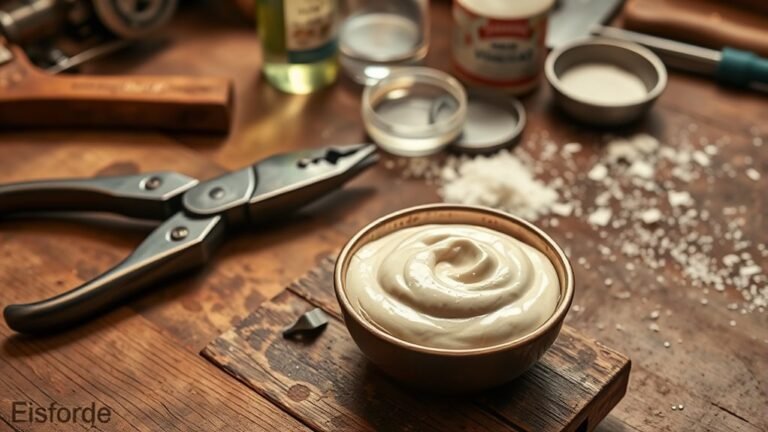How to Clean Your Coffee Machine Safely
To clean your coffee machine safely, first unplug it to avoid electrical hazards. Use gentle, non-abrasive tools like soft cloths and avoid harsh chemicals—white vinegar and baking soda work well for natural cleaning. Regularly descale your machine with manufacturer-approved solutions to prevent mineral buildup. Be sure to rinse removable parts thoroughly and dry them completely to prevent mold and leaks. Taking these steps will keep your machine working great and your coffee tasting fresh. There’s more to know about each type and maintenance tips to keep your brew perfect.
Understanding Your Coffee Machine Type

Before you start cleaning, it’s important to understand what type of coffee machine you have. Whether your machine runs on manual controls or boasts automatic features will affect how you approach maintenance. If your machine has manual controls, you’ll likely need to be hands-on during cleaning, carefully handling each part to avoid damage. On the other hand, machines with automatic features often include self-cleaning cycles, giving you more freedom from tedious scrubbing. Knowing this difference empowers you to clean efficiently without compromising your machine’s performance. Embrace the freedom to maintain your coffee maker in a way that suits its design. This understanding sets the foundation for safe, effective cleaning tailored to your machine’s unique needs.
Gathering the Right Cleaning Supplies
To clean your coffee machine effectively, you’ll need a few essential supplies on hand. Start by gathering the right cleaning tools—like soft cloths, brushes for small parts, and a measuring cup to mix solutions accurately. Choosing natural cleaners, such as white vinegar or baking soda, helps you avoid harsh chemicals and keeps your routine eco-friendly. These natural cleaners not only break down mineral build-up but also preserve the machine’s components. Having everything ready means you can clean your machine swiftly and thoroughly, giving you freedom from worrying about damage or residues. With the right cleaning tools and natural cleaners, you’re all set to maintain your coffee maker safely and enjoy great-tasting coffee every time.
Cleaning Drip Coffee Makers

Although drip coffee makers are straightforward appliances, regular cleaning is essential to keep them brewing fresh, flavorful coffee. Sticking to a drip coffee cleaning schedule frees you from stale tastes and machine clogs, letting you enjoy every cup without hassle. Here’s a simple routine to follow:
- Clean removable parts like the carafe and filter basket with warm, soapy water after each use.
- Run a mixture of equal parts white vinegar and water through the machine monthly to dissolve mineral buildup.
- Rinse by brewing a cycle of clean water to flush out any residue.
Cleaning Espresso Machines
Since espresso machines have more complex components than drip coffee makers, cleaning them properly is essential to maintain their performance and flavor quality. Start with daily espresso machine maintenance by flushing the group head and wiping down the steam wand after each use. Regularly backflush your machine using a cleaning detergent designed for espresso machines to remove coffee oils and residues deep inside. Don’t forget to clean the portafilter and baskets thoroughly. If you notice inconsistent pressure or strange tastes, espresso machine troubleshooting might reveal clogged filters or mineral buildup—descaling can fix these issues. Staying on top of maintenance frees you from unexpected breakdowns and keeps your espresso tasting fresh. By integrating these habits, you’ll enjoy your espresso machine’s full potential without hassle, embracing the freedom of perfect coffee at home.
Cleaning Single-Serve Coffee Brewers

To keep your single-serve coffee brewer running smoothly, you’ll need to descale it regularly by following a few simple steps. Don’t forget to remove and clean any detachable parts like the drip tray and water reservoir. This helps prevent buildup and guarantees every cup tastes fresh.
Descaling Process Steps
One essential step in maintaining your single-serve coffee brewer is descaling it regularly to prevent mineral buildup. This keeps your machine running smoothly and your coffee tasting fresh, freeing you from frustrating clogs and breakdowns. Here’s how to do it confidently:
- Choose a descaling solution or natural alternatives like vinegar or lemon juice. These break down stubborn minerals without harsh chemicals.
- Fill the water reservoir with your chosen solution, then run a brew cycle without a coffee pod, letting the solution clean the internal parts.
- Afterward, run two or three cycles with clean water to flush out any residue, ensuring your next cup is pure and delicious.
Descaling your brewer this way keeps your mornings liberated from machine troubles.
Cleaning Removable Components
Although descaling tackles mineral buildup inside your machine, cleaning removable components is just as essential for maintaining hygiene and performance. You’ll want to regularly detach all removable parts like the water reservoir, drip tray, and pod holder. Rinse these pieces under warm water and use mild soap if needed to remove oils and coffee residue. Cleaning frequency depends on how often you brew, but a good rule of thumb is once a week to keep everything fresh and functioning smoothly. By staying on top of this simple routine, you’ll avoid unpleasant tastes and potential clogs, giving you the freedom to enjoy every cup without hassle. Remember, taking a few minutes to clean removable parts guarantees your single-serve brewer stays reliable and delicious.
Descaling Your Coffee Machine
Because minerals from water build up over time, descaling your coffee machine is essential to keep it running smoothly and tasting great. Mineral buildup can clog your machine, affecting flavor and performance. To free yourself from these issues, follow this simple process:
- Choose a safe descaling solution designed for your machine to dissolve mineral deposits effectively.
- Run the descaling solution through the machine as per instructions, allowing it to reach every internal part.
- Rinse thoroughly with fresh water to flush out any residue, ensuring your coffee tastes pure and fresh.
Regular descaling empowers you to enjoy your coffee freely, without the frustration of malfunction or bitter brews. Take control and keep your machine in top shape!
Maintaining Your Coffee Machine Regularly
To keep your coffee machine working efficiently and extend its lifespan, maintaining it regularly is essential. By committing to routine maintenance, you guarantee your coffee machine longevity, saving you time and money while enjoying freedom from unexpected breakdowns. Simple steps like wiping down the exterior, cleaning removable parts after each use, and regularly checking for wear can make a huge difference. Don’t forget to replace water filters as needed and run cleaning cycles with appropriate solutions. Keeping your machine dry and storing it properly between uses also helps prevent damage. With these consistent habits, you maintain control over your coffee routine, guaranteeing every cup tastes great without interruptions or costly repairs. Your coffee machine will thank you with lasting performance and reliability.
Tips for Avoiding Common Cleaning Mistakes
To keep your coffee machine in great shape, you’ll want to use the right cleaning agents and avoid harsh chemicals. Being careful not to let water seep into sensitive parts can prevent costly damage. These simple precautions will help you clean safely and extend your machine’s life.
Use Proper Cleaning Agents
Many cleaning mistakes happen when people use the wrong agents on their coffee machines. You want to keep your machine running smoothly without risking damage or harmful residues. Choosing safe alternatives and eco friendly options lets you clean effectively while protecting your health and the planet. Here’s what to remember:
- Avoid harsh chemicals like bleach or ammonia—they can corrode parts and leave toxins.
- Opt for natural cleaners such as vinegar or baking soda, which break down buildup safely.
- Use products labeled for coffee machines to guarantee compatibility and performance.
Prevent Water Damage
Choosing the right cleaning agents is just one part of keeping your coffee machine in top shape. To truly protect your machine, you need to prevent water damage by being mindful during cleaning. Always avoid overfilling water reservoirs, as this can cause water leaks that damage internal components. After cleaning, make sure to thoroughly dry removable parts to stop moisture buildup, which can lead to mold or corrosion. Don’t leave your machine plugged in while cleaning to prevent electrical risks from any accidental water exposure. Taking these simple steps not only safeguards your coffee maker but also gives you the freedom to enjoy your brew without worrying about costly repairs. Keep your machine dry, leak-free, and well-maintained for a long-lasting coffee experience.
Häufig gestellte Fragen
Can I Use Vinegar Instead of Commercial Descaling Solutions?
You can totally use vinegar as a descaling alternative to commercial solutions. Vinegar benefits include being natural, affordable, and effective at breaking down mineral buildup in your coffee machine. However, you’ll want to dilute it properly to avoid any lingering odors or damage. If you’re all about freedom and simplicity, vinegar lets you ditch harsh chemicals while keeping your machine clean—just rinse thoroughly afterward to keep the taste pure and fresh.
How Often Should I Replace Coffee Machine Filters?
Think of your coffee machine filters like the unsung heroes—they quietly keep your brew pure. Depending on filter types—paper, metal, or cloth—your replacement schedule varies. Paper filters are usually single-use, so toss them after each brew. Metal or cloth filters can last weeks but need thorough cleaning to avoid buildup. Stick to this routine, and you’ll enjoy freedom from off-flavors, savoring every cup just the way you like it.
Is It Safe to Clean My Coffee Machine With Bleach?
You might wonder about bleach safety when cleaning your coffee machine, but it’s generally not recommended. Bleach can leave harmful residues and affect your coffee’s taste. Instead, you’ve got plenty of cleaning alternatives like vinegar or baking soda, which are safer and eco-friendly. These options let you keep your freedom to enjoy fresh coffee without risking health or machine damage. Stick with natural solutions to keep things clean and worry-free.
Can I Run My Coffee Machine Through a Dishwasher Cycle?
Running your coffee machine through a dishwasher cycle is like trying to fit a square peg in a round hole—it usually doesn’t work well. You’ve got to take into account dishwasher safety since many machines have parts made from delicate materials like plastic or metal that can warp or corrode. Instead, it’s best to clean removable parts by hand to keep your freedom intact and your machine running smoothly without damage.
What Should I Do if My Coffee Machine Leaks After Cleaning?
If your coffee machine leaks after cleaning, first check for common leak causes like improperly seated parts or worn-out seals. Start troubleshooting by inspecting the water reservoir, drip tray, and any connections to verify they’re secure and aligned. Don’t force anything—take your time to reassemble correctly. If leaks persist, consult your user manual or contact customer support. Taking these steps helps you regain control and enjoy your coffee without hassle.






